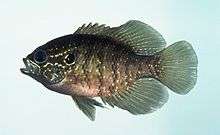Banded sunfish
The banded sunfish (Enneacanthus obesus) is a freshwater fish of the family, Centrarchidae. They can grow to 2–3 inches long. They are native to North America.
| Banded sunfish | |
|---|---|
 | |
| Banded sunfish at the New England Aquarium | |
| Scientific classification | |
| Kingdom: | Animalia |
| Phylum: | Chordata |
| Class: | Actinopterygii |
| Order: | Perciformes |
| Family: | Centrarchidae |
| Genus: | Enneacanthus |
| Species: | E. obesus |
| Binomial name | |
| Enneacanthus obesus (Girard, 1854) | |
| Synonyms[2] | |
|
Pomotis obesus Girard, 1854 | |
Description
The banded sunfish is similar to the blackbanded sunfish and has a very compressed and deep body. Its sides are iridescent and dark colored. There are dark bands on its side and nuptial males and females will develop blue specks on their bodies. Its mouth is upturned and its pectoral and tail fins are rounded. It grows to an approximate length of 9.5 cm. [3]
Distribution
The banded sunfish is found in the Atlantic coastal drainages of North America from southern Maine south to central Florida and along the Gulf slope as far west as the Perdido River drainage in Alabama.[1]
Habitat
The banded sunfish is found in small ponds and backwaters of creeks to small and large rivers and boggy brooks over sand or mud in sluggish, acidic, heavily vegetated waters.[3]
Diet
The banded sunfish feeds upon aquatic insects, microcrustacean.[3]
Reproduction
Spawning occurs from April through July. They can spawn when they become one year old. The male will construct a sand or gravel nest where the eggs are laid but does guard the eggs as the eggs are buoyant and float way from the nest.[3]
Status
The banded sunfish is currently endangered in Pennsylvania, New York, New Jersey, New Hampshire, and Connecticut.[4] Globally, however, its population is stable and is listed as Least Concern on the IUCN Red List.[1]
Taxonomy and etymology
The banded sunfish was first formally described as Pomotis obesus in 1854 by the French ichthyologist Charles Frédéric Girard (1822-1895) with the type locality given as Framingham and in a branch of the Charles River, at Holliston, Massachusetts.[5] The generic name Enneacanthus means "nine-spined" while the specific name obesus means "fat".[6]
References
- NatureServe (2013). "Enneacanthus obesus". IUCN Red List of Threatened Species. 2013: e.T202442A15361644. doi:10.2305/IUCN.UK.2013-1.RLTS.T202442A15361644.en. Retrieved 24 May 2020.
- Froese, Rainer and Pauly, Daniel, eds. (2019). "Enneacanthus obesus" in FishBase. December 2019 version.
- "Banded sunfish (Enneacanthus obesus)" (PDF). Pennsylvania Natural Heritage Program. Retrieved 24 May 2020.
- "CT DEP: Endangered, Threatened & Special Concern Fish". web.archive.org. 2006-12-06. Retrieved 2019-11-28.
- Eschmeyer, W. N.; R. Fricke & R. van der Laan (eds.). "Pomotis obesus". Catalog of Fishes. California Academy of Sciences. Retrieved 24 May 2020.
- "Banded Sunfish". Outdoor Alabama. Retrieved 24 May 2020.
